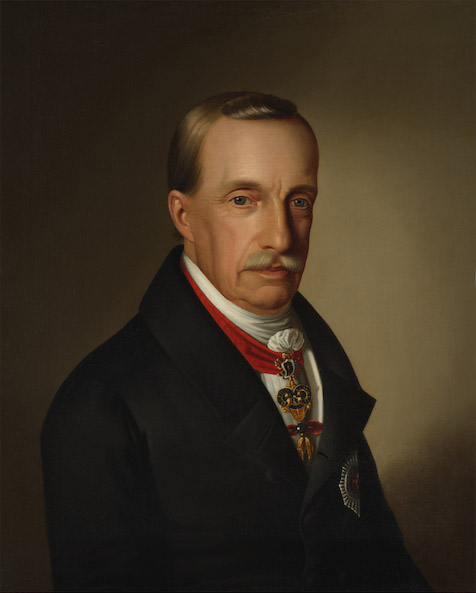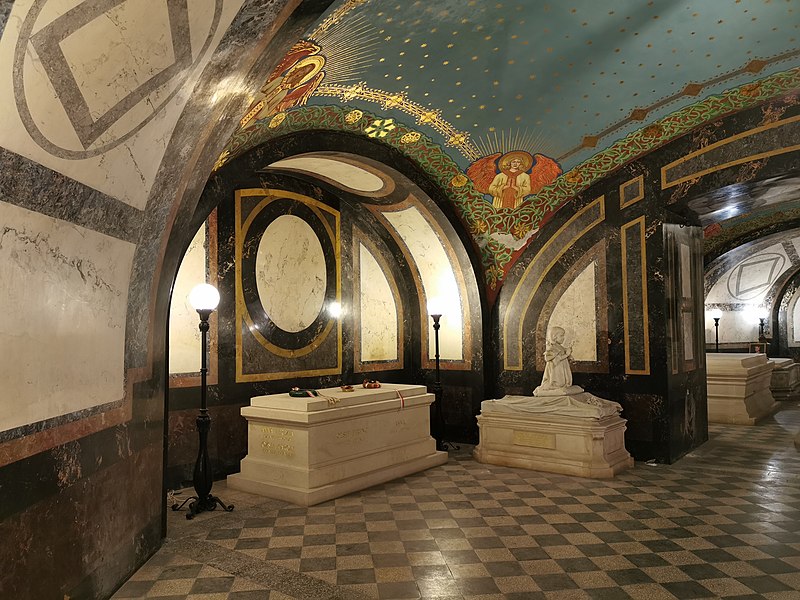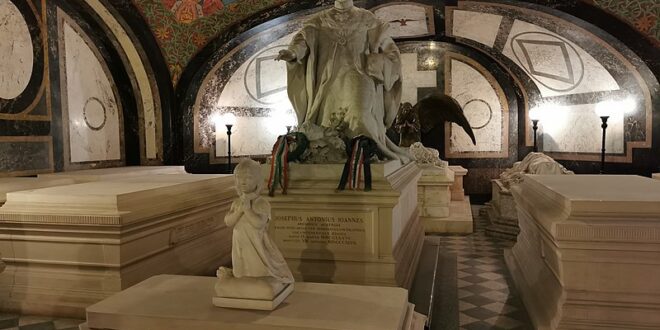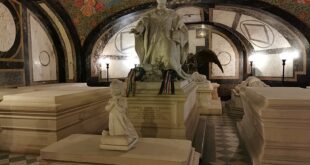The Palatinal Crypt dedicated to the Palatine or Representative of the Emperor of the Austro Hungarian Empire, Palatine Joseph (Joseph Anton Johann Baptist) and his family is situated under the Buda Castle Royal Palace, more specifically under the wing of Hungarian National Gallery. The crypt is the burial place of Archduke Joseph and his lineage. Joseph became the representative of the Monarch in 1795 at the age of 19 and remained in this position until 1847. The Crypt was completed in 1838 in the year of the Greatest Danube Flood in Pest – Buda town (at that time not united as Budapest yet). The crypt consists of three interconnected chambers.

First Room of the Palatinal Crypt in Buda Castle
The first room of the Palatinal Crypt serves as a chapel mainly used for ceremonial purposes. Kindly note that the chapel and the rest of the chambers can only be visited with special permission (to be gained form the Tourism department of the Hungarian National Gallery – mng.hu – under which the Palatinal Crypt can be found and accessed with a live guide).
Central Chamber in the Palatinal Crypt
In the central chamber rest two children in the stone sarcophagi: Gisela and Matthias, great-grandchildren of Archduke Joseph, the palatine or representative of the monarch while the Emperor was away from Hungary (as part of the dual monarchy of the Austro Hungarian Empire). Gisela’s sarcophagus is topped with an endearing statue of her as a child, sculpted by Károly Senyei based on her photograph. Gisela was the daughter of Archduke Joseph, Palatine of Hungary, and his third wife, Princess Maria Dorothea of Württemberg. She lived a very short life, passing away at just four years old. Mathias was the son of Archduke Joseph, Palatine of Hungary, and his third wife, Duchess Maria Dorothea of Württemberg. He tragically lived only a year before his passing.

Third Chamber of the Palatinal Crypt
The innermost room is the main “Palatinal Crypt” i.e. the resting place of Archduke Joseph. Its grand arch is decorated with colourful stone plaster, inspired by the marble walls of Florence’s Medici tomb. Side arches display frescoes of angels, and the crypt ceiling is painted to resemble a starlit sky.
At the crypt’s center lies Archduke Joseph’s massive stone sarcophagus, featuring a statue of him in white marble, twice life-sized, crafted by the era’s excellent sculptor, Gyorgy Zala. The statue depicts the Palatine, the son of Leopold II, Holy Roman Emperor and King of Hungary, Croatia and Bohemia (today Czech) kneeling, protectively extending his right hand over the Hungarian crown. You can see the original Holy Crown on display at the Hungarian Parliament in a special protected room, the Holy Crown room. Flanking the Archduke’s resting place are the sarcophagi of his third wife, Maria Dorothea, on the eastern side (left), and his second wife, Maria Hermine, on the western side (right).
Facing the Archduke’s statue near the entrance is the sarcophagus of his daughter, Elisabeth Clementine. Elisabeth, the daughter of Archduke Joseph and Maria Dorothea of Württemberg, is buried in the Palatinal Crypt. She passed away at only ten months old, and her resting place is marked with a small white marble statue, crafted by sculptor Alajos Stróbl, near the crypt’s entrance.
Archduchess Elisabeth Caroline Henrika of Austria was the first child of Archduke Joseph and his third wife. After the many losses, it came as a painful loss that their first child died in the year she was born, 1820, after 23 days. Baby Elisabeth was the first to be buried (without being embalmed) in the Palatinal Crypt.
Maria Hermine of Anhalt-Bernburg-Schaumburg-Hoym was the second wife of Archduke Joseph, Palatine of Hungary. The archduke married him after spending over a decade in widowhood. Maria Hermine was 22 years younger when they got married and was much respected by Hungarians. She established the first charity for women in Hungary. Sadly, in 1817, she passed away at the young age of 20 in childbirth. Their marriage was short, and they had two children, twins, together.
Archduke Joseph and his second wife, Princess Hermine of Anhalt-Bernburg-Schaumburg-Hoym, had a beautiful frail daughter called Princess Hermine – Erzherzogin and her twin brother, Archduke Stephen Francis Victor. After her mother’s early death, Hermine was raised by her stepmother, Maria Dorothea of Württemberg. Princess Hermine grew up in Buda and at the family’s Alcsútdoboz estate, where she received a thorough education. She never married and later became a nun in 1837. Maria Hermine became Princess-Abbess of the Theresian Royal and Imperial Ladies in Prague, in the Castle until her death in Vienna in 1842. Her father, Archduke Joseph ordered to bring her body to the Buda Castle Royal Palace in the family crypt. The residents of Pest – Buda (later joined and renamed as Budapest) paid their tributes by crossing the icy waters of the Danube, risking the melting ice of the river. The much revered princess later on received her own chapel in Zuglo (Herminamezo) from the donations of the city (not from Habsburg treasury).
Maria Dorothea of Württemberg was the third wife of Archduke Joseph, Palatine of Hungary. Together, they had five children: Elisabeth, Alexander, Joseph Karl, Maria Henrietta, and Stephen, who would later serve as Palatine of Hungary. The couple shared a main goal to make Hungarian the main official language of Hungary instead of Latin. For this reason, Maria learnt to converse in Hungarian and often visited Hungarian noble families, the Karolyis, Szechenyis to pursue her mission and to aid the development of charitable institutions in Hungary.
To the left of the entrance lies the sarcophagus of baby Alexandrina, the daughter of Alexandra Pavlovna, Archduke Joseph’s first wife, whose happy marriage to the duke came to a tragic end when giving birth to their first child, Alexandrina, who only lived in the first hour. The casket (and the death certificate) bears the name Paulina so historians do not agree about the baby’s name little Alexandra / Alexandrina or Paulina are both used due to the lack of birth registry (which is customary when the baby is baptised after death). Her remains were transferred in an urn to the crypt in 1838.
Alexandra Pavlovna of Russia was the first wife of Archduke Joseph, Palatine of Hungary, and the daughter of Tsar Paul I of Russia. They had a happy but tragically short marriage, marked by political intricacies as well as great celebrations, including the notable concert in the Buda Castle given on 7 May 1800 by the composer Ludwig van Beethoven himself playing for the couple, Archduke Joseph and his wife Alexandra at the Royal Palace, as a culmination of a week-long celebrating the Archduke’s beautiful wife, Alexandra. She tragically died young on March 16, 1801, at the age of 17 due to childbed fever (postpartum complications). Alexandra and Archduke Joseph had one daughter, Alexandrina (Paulina / Paula), who was born on in 1801, but died shortly after birth. The Archduke’s second wife, Alexandra Pavlovna, was not buried in the crypt. Instead her body was mourned for six weeks according to orthodox traditions, then placed to rest in a mausoleum built in Urom in Hungary (close to Budapest).
The Mausoleum survived the world wars, however, in 1981 the holy place was looted by thieves, profaning Alexandra’s remains and the coffin’s valuables, jewellery and clothing were completely robbed. Over twenty years, Alexandra’s remains were transferred to and stored in the crypt of Buda Castle. In 2004, until which the Archduchess rested along the children and wives of her widower, the body was placed again in the restored Urom mausoleum in a holy Orthodox ceremony lead by the head of the Russian Orthodox Church in Hungary and attended by the Habsburg and Romanov family members.
On the crypt’s southern wall, a large bronze statue of the Angel of Peace spreads its wings over the deceased. Below this statue rest Archduke Joseph’s son, Joseph Karl, and his daughter-in-law, Clotilde, their shared memorial sculpted by György Zala from white marble based on their death masks.
Joseph Karl, son of Archduke Joseph, Palatine of Hungary, and his third wife, Maria Dorothea of Württemberg, was born in 1833, and lived until 1905. Though not as politically active as his father, Joseph Carl had a significant role in the Hungarian military and was involved in various charitable activities. He was also a well-regarded member of the Hungarian aristocracy and maintained close ties with the Habsburg family, supporting Hungarian culture and society throughout his life. As a notable contribution to ethno-linguistic research, Joseph Karl, son of Archduke Joseph, held a strong interest in the Romani language and corresponded with Albert Thomas Sinclair, an American lawyer who shared this passion. Sinclair’s biography mentions that the Archduke sent him a copy of his work—a large, elegantly bound octavo volume—described as a significant philological resource that compares Romani words with Sanskrit, Hindustani, Persian, and other languages.
On the western wall stands the stone sarcophagus of Ladislaus Philip, Archduke Joseph’s grandson, who died tragically young. His marble likeness, crafted by Alajos Stróbl, was also sculpted from his death mask.
Ladislaus Philip, grandson of Archduke Joseph, was born in 1875, as the son of Joseph Karl and Princess Clotilde of Saxe-Coburg and Gotha. Tragically, he lived only 20 years, passing away in 1895, following a hunting accident. While his young age prevented him from achieving notable accomplishments, his untimely death left a lasting impact on the Habsburg family, and he is remembered through his monument in the Palatinal Crypt.
Archduke Alexander Leopold Ferdinand, the second child of Archduke Joseph and Maria Dorothea of Württemberg, is also buried in the Palatinal Crypt. He lived a relatively short life, passing away at 12 years old in 1837, and was laid to rest alongside other members of his family within the crypt. His death was caused by an unidentified infectious disease, showing similar symptoms to typhoid.
Not Buried in the Palatinal Crypt
Archduke Stephen Francis Victor, Erzherzog Stephan Victor, was the son of Archduke Joseph and his second wife, Hermine of Anhalt-Bernburg-Schaumburg-Hoym. His mother died shortly after giving birth, and like Hermine, his twin sister, he was also brought up by their stepmother, Maria Dorothea of Württemberg, their mother’s cousin. Archduke Stephen is not buried in the Palatinal Crypt despite that fact that he was the last actual palatine of Hungary (1847 – 1848). He resigned in Sep 1848 as a direct consequence of the Hungarian revolution (after the revolution, the title of palatine became largely symbolic). After political challenges and exile due to his involvement in Hungarian conflicts with the Habsburg court, Stephen spent his final years in Bavaria. He was buried there in 1867, in the family crypt at the Tegernsee Abbey in Germany. During the turbulent year of 1848, Archduke Stephen Victor’s actions led to his fall from favour, resulting in his banishment from the court in Vienna. He retired to his mother’s estates at Schaumburg, where he lived quietly, dedicating himself to scientific studies in mineralogy and geology. It was not until 1858, at the christening of Archduke Rudolf, the new heir to the throne, that he was permitted a brief return to Vienna. Leading a solitary life, he never married and continued his reclusive existence at Schaumburg, battling lung disease that ultimately claimed his life in 1867. That same year, the Austro-Hungarian Compromise (Ausgleich) was enacted, and his remains were transported to Budapest, where he was buried with widespread public sympathy—an acknowledgment of his unfulfilled efforts to prevent the civil war in 1848.
Maria Henriette of Austria, the daughter of Archduke Joseph and Maria Dorothea of Württemberg, is not buried in the Palatinal Crypt. After she lost her father at the age of ten, she found great solace and joy in horse riding. Some even say she was raised as a free spirit in a boy’s lifestyle. Eventually, she was forced to marry King Leopold II of Belgium, despite her (and his) strong protests, and became Queen of Belgium. Maria Henrietta lived in Belgium as the ‘Queen of Spa’ until her death in 1902, and she was buried in the royal crypt at the Church of Our Lady of Laeken in Brussels.
Archduchess Elisabeth Franziska Maria of Austria, the third child of Archduke Joseph and his third wife, is not buried in the Crypt under the Buda Royal Palace. Elisabeth passed away from pneumonia at her son’s residence, the Albertina Palace in Vienna. She was laid to rest in Baden bei Wien, where a street now bears her name in her honour.
Alexandra Pavlovna, the first wife of the Archduke was moved back to the orthodox mausoleum after a long temporary placement in the crypt.
Something is historically incorrect? Please let us know.
Source of Photos: Wikimedia
Updated: 25th Oct 2024
 Buda Castle Buda Castle, Budapest
Buda Castle Buda Castle, Budapest


